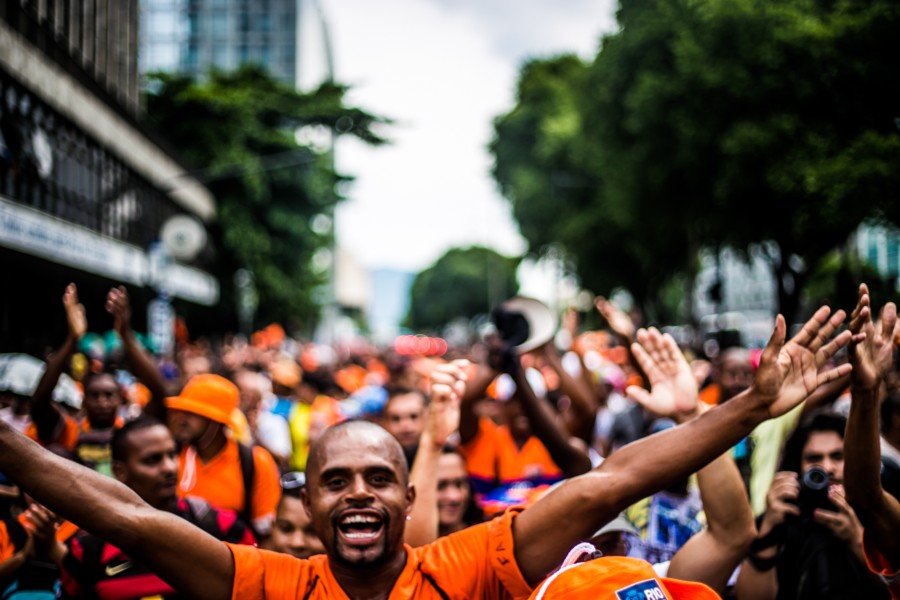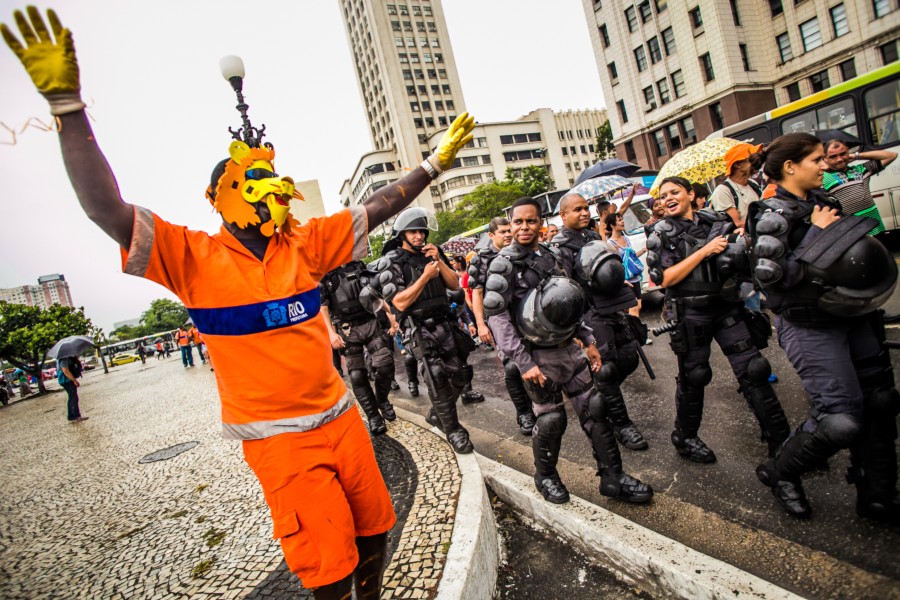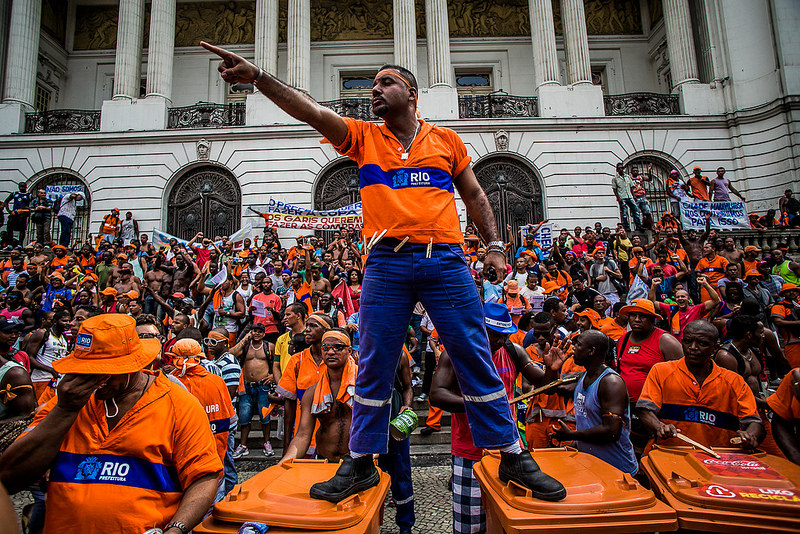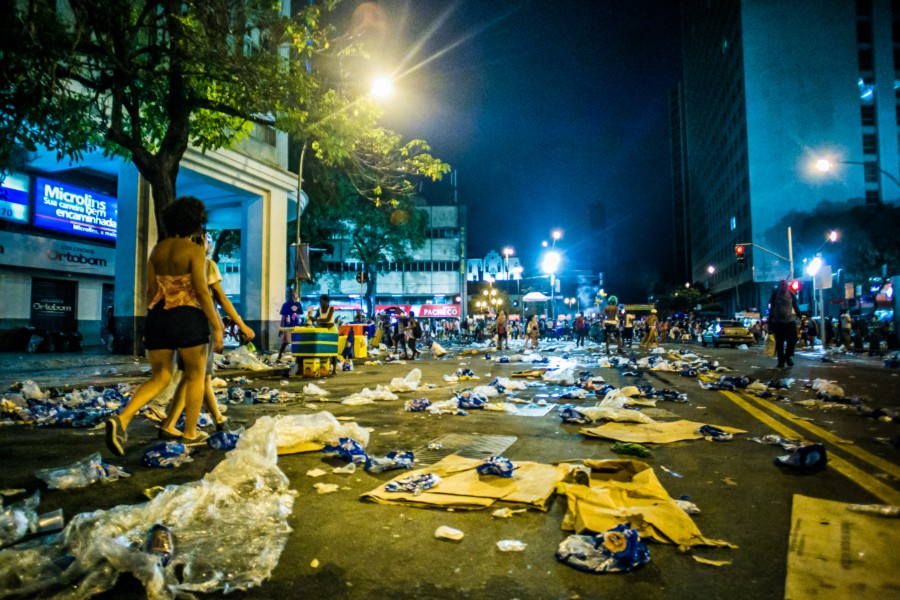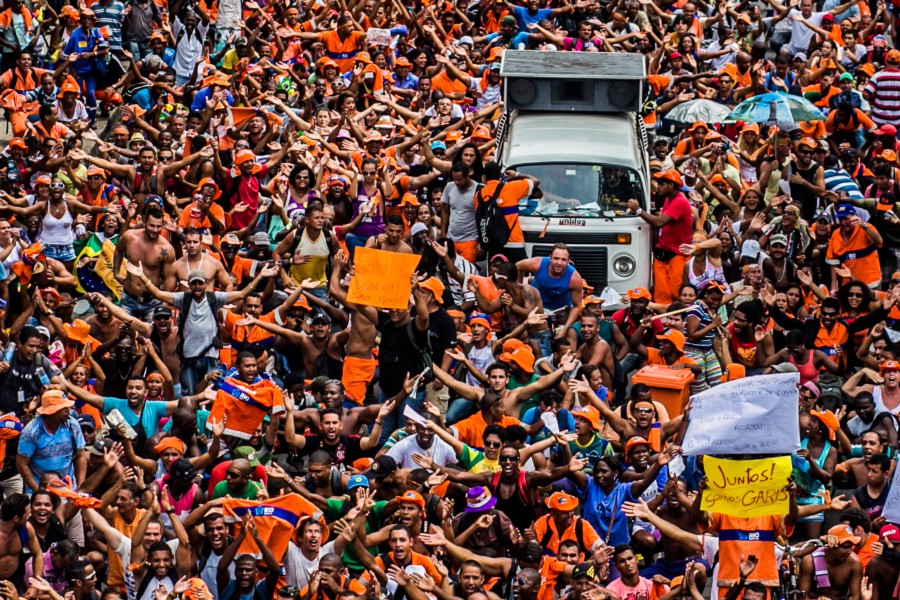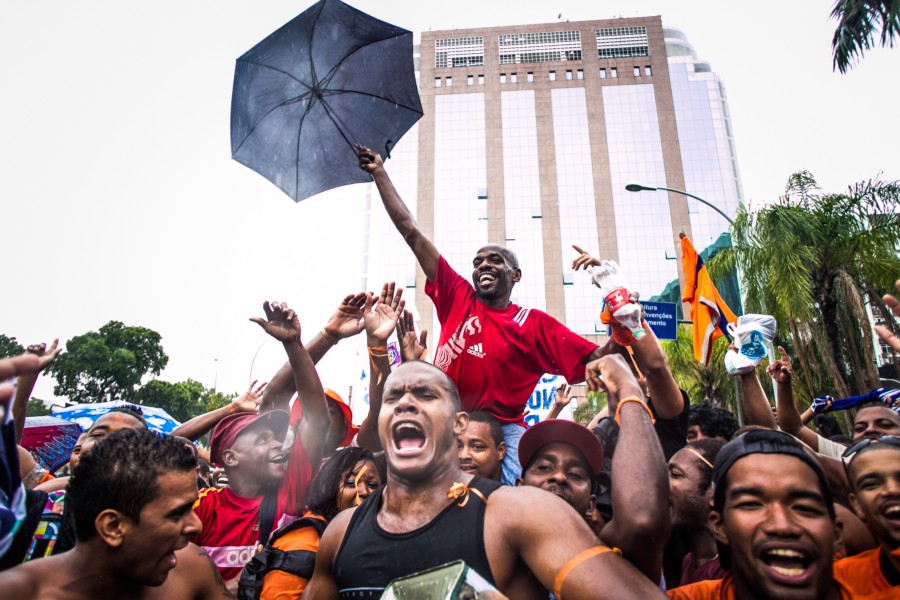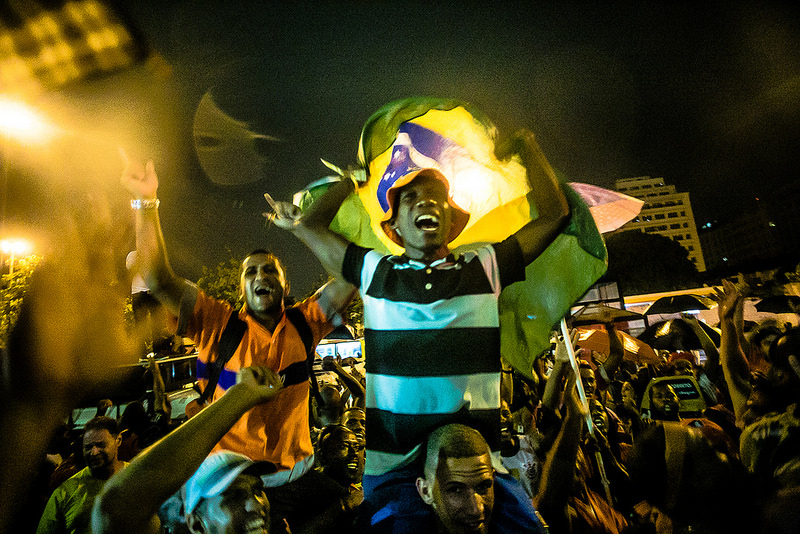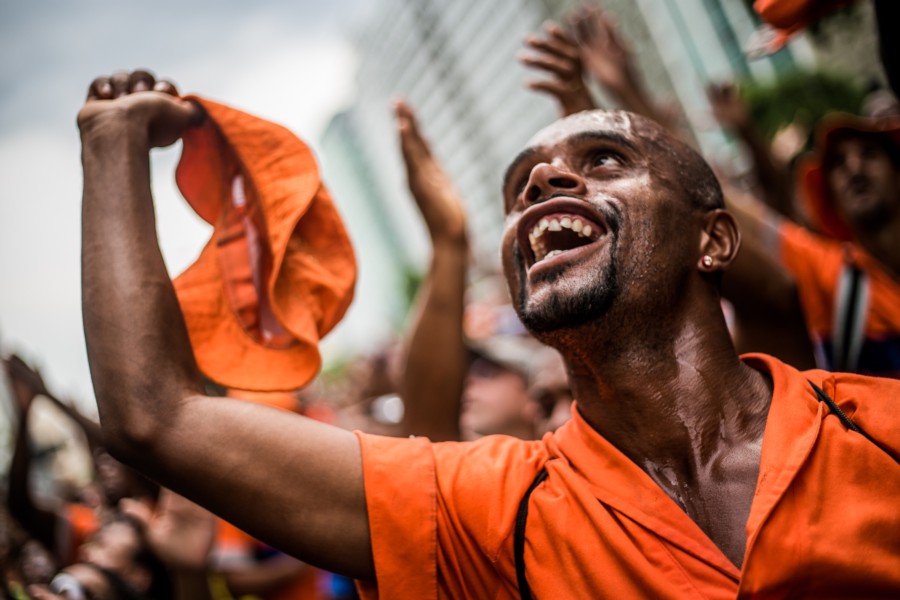For the original by Mídia NINJA in Portuguese on Medium click here.
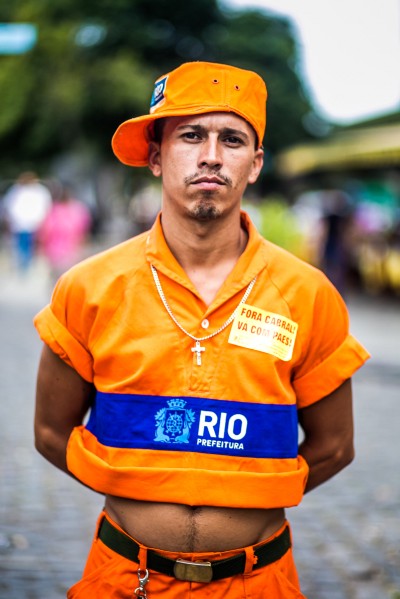 They clean the litter off the streets and sidewalks daily. They have the dirtiest and one of the least valued jobs in our society. Despite their fluorescent orange uniforms, they are invisible to the majority of people. They work up to 12 hours a day, for a monthly salary of R$800 (US$344), rushing around the city, always in a humble way. They live in the favelas, and the majority of them are black. Their labor union has been commanded by the same political group for decades. They make wage agreements behind closed doors with local businesses and City Hall, and donate money to the political campaigns of politicians who call the strikers vandals and thugs.
They clean the litter off the streets and sidewalks daily. They have the dirtiest and one of the least valued jobs in our society. Despite their fluorescent orange uniforms, they are invisible to the majority of people. They work up to 12 hours a day, for a monthly salary of R$800 (US$344), rushing around the city, always in a humble way. They live in the favelas, and the majority of them are black. Their labor union has been commanded by the same political group for decades. They make wage agreements behind closed doors with local businesses and City Hall, and donate money to the political campaigns of politicians who call the strikers vandals and thugs.
They are part of an enormous new and precarious working class, which in the last years, despite many difficulties, has disputed an unprecedented space within Brazilian society. The poor, now included even more by a popular government, have a new horizon and utopia beyond a plate of food. In their new social position they learned how to use the Internet. They bought cell phones, laptops and generic tablet computers. They learned of a space where they could relate to one another and organize without being burdened by the patrols imposed by the labor organizations, the State, the Capital, and the Media.
They danced samba, from social networks to the streets, and started a victorious protest during the middle of Rio de Janeiro’s Carnival. This is the story of Rio’s garis (trash collectors).
The Avenue
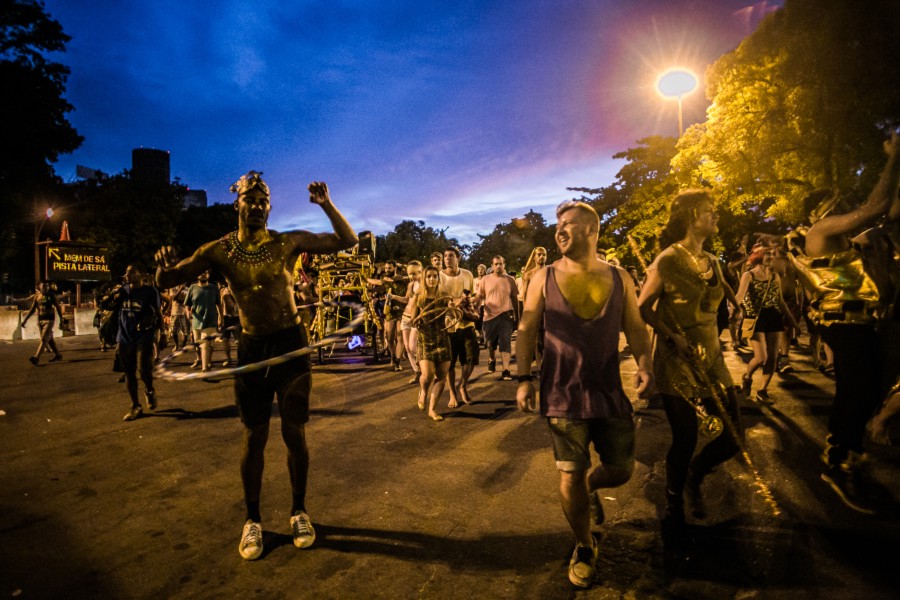 Rio de Janeiro is Brazil’s major postcard location. Known as the Marvelous City, it is also a place where contradictions and inequalities most jump out. The favelas are located next to upper class neighborhoods, beaches, and streets, where with their democratic nature, a diverse population mixes in an everyday multicultural and complex melting pot.
Rio de Janeiro is Brazil’s major postcard location. Known as the Marvelous City, it is also a place where contradictions and inequalities most jump out. The favelas are located next to upper class neighborhoods, beaches, and streets, where with their democratic nature, a diverse population mixes in an everyday multicultural and complex melting pot.
It is also the city of samba and an international symbol for the largest public party in the country: Carnival. More than anything, Rio was the main arena of Brazilian activism following the large protests of June 2013.
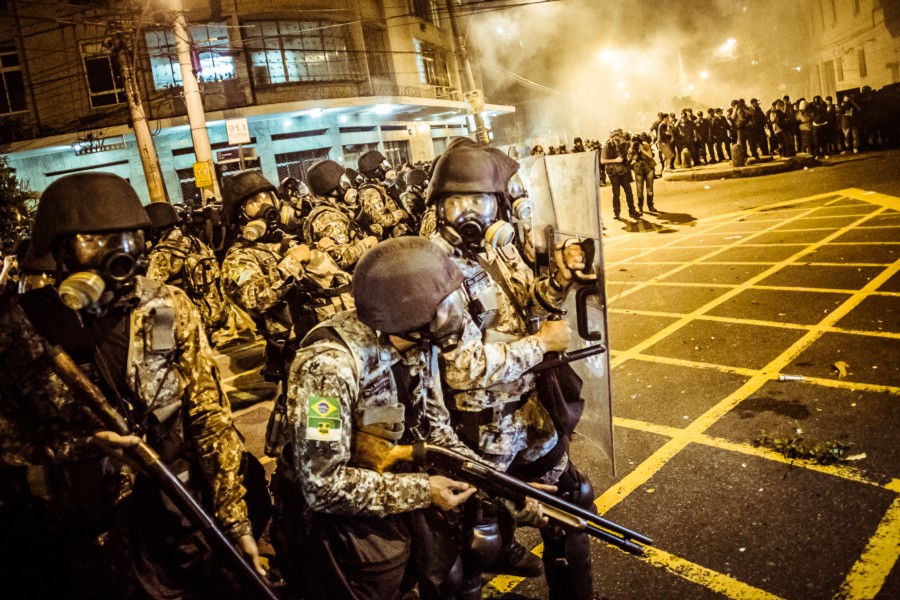 In Rio there wasn’t a truce. Professors, black blocs, media-journalists and organized sectors have maintained the fervor of the streets. Even as the rest of Brazil has cooled off, they continue with mass mobilizations, symbolic acts and direct action. As a result, it has become known as the city where public movements have suffered the most from police violence and criminalization by conservative forces and mass media corporations.
In Rio there wasn’t a truce. Professors, black blocs, media-journalists and organized sectors have maintained the fervor of the streets. Even as the rest of Brazil has cooled off, they continue with mass mobilizations, symbolic acts and direct action. As a result, it has become known as the city where public movements have suffered the most from police violence and criminalization by conservative forces and mass media corporations.
The recent death of journalist Santiago Ilídio Andrade at the beginning of February, who was accidentally struck by a stray firework set off by protestors, caused the condemnation of not only the two boys who supposedly lit the explosive, but for all and any form of popular protest. The weight of death fell over the streets, and with it the rhetoric and ideological burden that violence could threaten this democracy.
In a contradictory way, but with clear interests on the part of hegemonic sectors, this space transformed itself, just as much for conservatives as it did for the traditional left, into a dangerous zone for dictatorial reveries. In order to protect against the greater evil, it was necessary to support other evils: an anti-terrorism law reached Congress.
The social movements were threatened directly and a climate of uncertainty and insecurity circled a good part of the evaluations and political readings in the country, making this electoral year, with the World Cup rapidly approaching, even more complicated. The important role the new movements and political tactics were carrying out in this recent history of Brazilian democracy were now threatened. It was time for the city to open its aisles for the arrival of Carnival.
The Adversaries
On Saturday March 1, Brazilian Carnival officially began. After initial communication started on social networks, by communities and profiles created by the garis, Comlurb (Rio’s waste management company) employees went on strike. The demands of the strike were a base monthly salary of R$1,200 (US$514), 40% increase in workers’ compensation due to poor health conditions on the job, and a readjustment of the food voucher value from R$12 (US$5.15) to R$20 (US$9). The timing of the strike could not have been more appropriate. During Carnival, the city’s streets become swamped with trash, and the garis‘ job is fundamental for the visual aspect of the party. The traditional scene of the men in orange crossing the Sambodrome avenue behind the samba school parades is a part of the Brazilian Carnaval image.
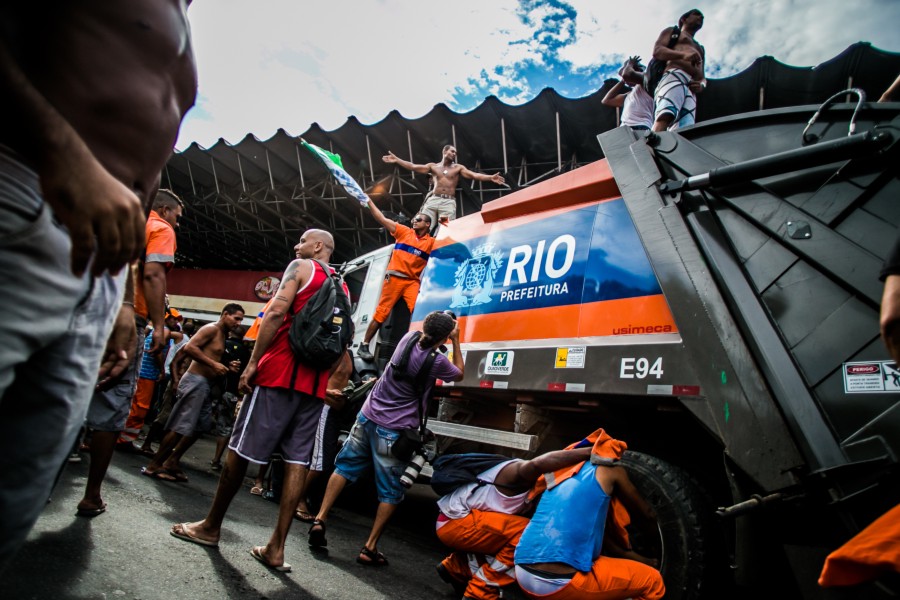 But the garis simply stopped working, and no one saw it coming.
But the garis simply stopped working, and no one saw it coming.
The labor union for Comlurb workers, which has been controlled by the same group for years, has historically negotiated the salary agreements in discussions that are in no way transparent. The political relations between union leaders and the government creates a cloud of distrust as to whether the true interests of the garis are being defended by the union.
We do not want to see the city dirty. We are garis. But on this salary how are we going to eat? Trash?
–Marcelo Américo, 34 years old, gari from Guadalupe
This sentiment was one of the motivating factors for the first debates and challenges brought to the streets and city squares and great public discussions by the garis in Rio de Janeiro.
The position of the city government and mayor from the very beginning was to deny and disqualify the strikers’ movement, collaborating with the labor union. The mayor publicly declared the strikers were a minority composed of vandals and accused them of mutiny.
I would not call it a strike. It is a rebellion by a group of people who are coercing those who want to work. Strikes are declared by the union.
–Mayor Eduardo Paes
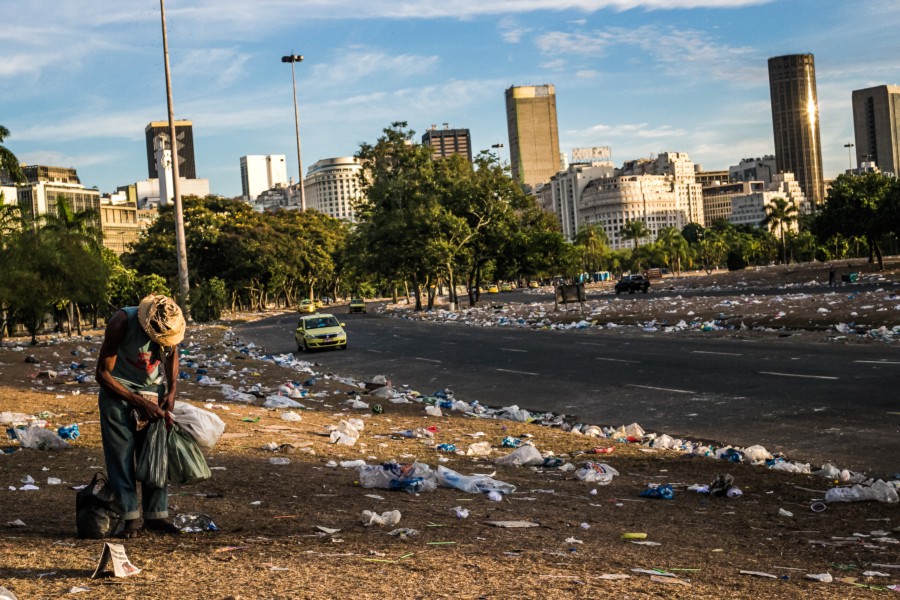 The discomfort with the halt in trash collection during a time of public partying and of great visibility for the city was used in a moralist and emotional way. How was it possible to stop at a time like this? How could the thousands of tourists stand a city filled with trash on the eve of the World Cup? How could the garis be so irresponsible?
The discomfort with the halt in trash collection during a time of public partying and of great visibility for the city was used in a moralist and emotional way. How was it possible to stop at a time like this? How could the thousands of tourists stand a city filled with trash on the eve of the World Cup? How could the garis be so irresponsible?
In a brutal inversion of values, the irresponsibility over the city’s management was transferred onto the shoulders of the already tired working class, who demand their rights be met, rather than the public sector and its elected representatives.
The union, distancing itself from the conditions requested, closed the deal with a pitiful 9% increase for salaries and declared, in an artificial way, the end of the strike. It was all staged by the city government and the mainstream media.
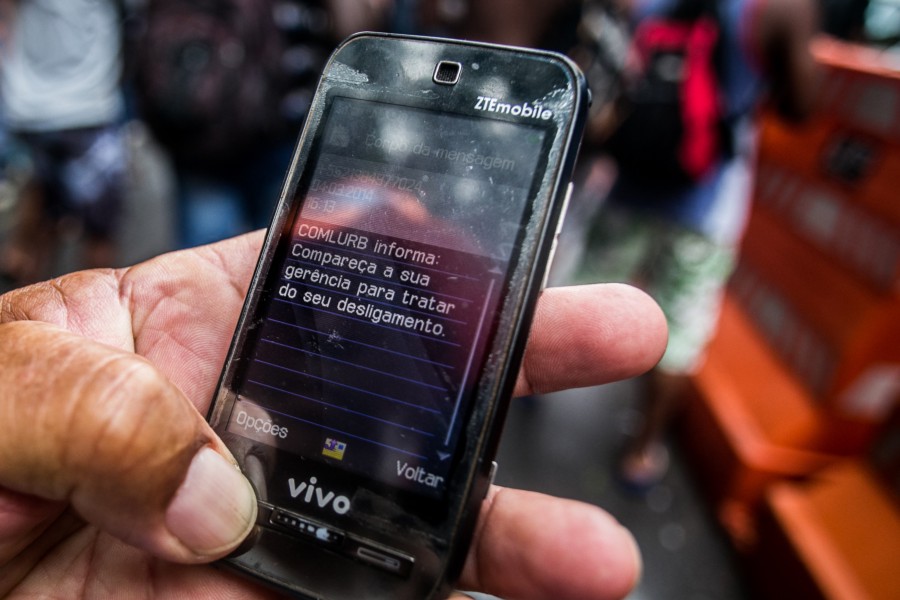 The labor court considered the strike illegitimate. Comlurb initiated a policy of intimidation by sending cards, telegrams, and even text messages to individuals announcing a mass dismissal of the striking garis.
The labor court considered the strike illegitimate. Comlurb initiated a policy of intimidation by sending cards, telegrams, and even text messages to individuals announcing a mass dismissal of the striking garis.
The Military Police and an armed private escort were placed on the streets to guarantee the garis return to work, and a defamatory campaign against the strike was orchestrated.
Various rumors were initiated with the support of the media to try to disqualify the movement, amounting to a blatant policy of intimidation and dismissals.
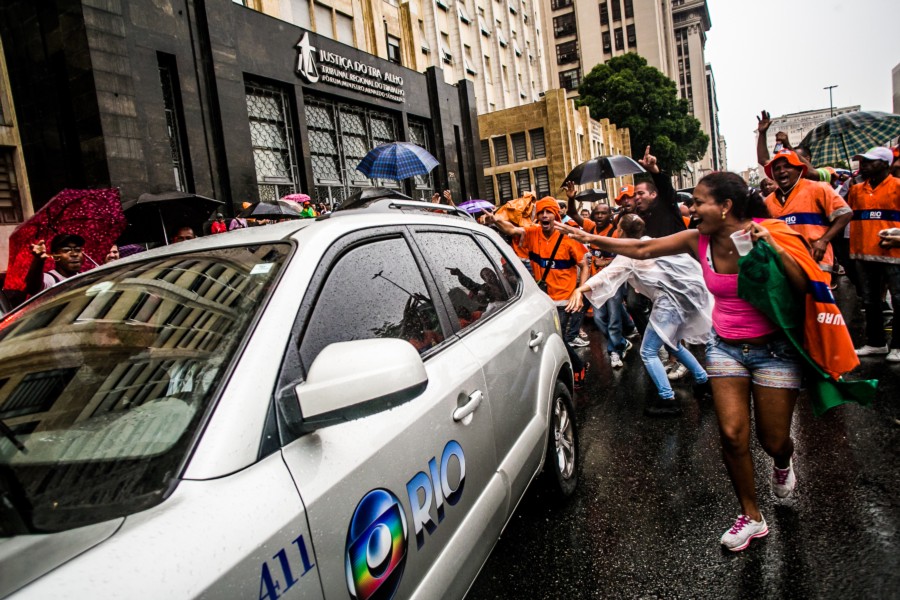 Meanwhile, the powerful media groups, principally the Globo Organization, acted as the City’s official press office, embarking on a defamatory wave to destroy the movement. Extensive reports in the O Globo newspaper and Jornal Nacional TV news appeal to the legal arguments, the non-recognition of the strike by the union and the noncompliance of the workers to manipulate public opinion against the garis.
Meanwhile, the powerful media groups, principally the Globo Organization, acted as the City’s official press office, embarking on a defamatory wave to destroy the movement. Extensive reports in the O Globo newspaper and Jornal Nacional TV news appeal to the legal arguments, the non-recognition of the strike by the union and the noncompliance of the workers to manipulate public opinion against the garis.
The trash accumulates in the streets and on the beaches. The bad smell, characteristic of certain poorer areas of the city (which suffer from chronically poor collection), arrives in the center and the (wealthy) South Zone of Rio de Janeiro.
At the same time, deeper wounds of our political reality start being exposed by the movement. The feelings of abuse and disconnect from reality of Mayor Eduardo Paes’ government, and consequently the larger part of the Brazilian political class, were reinforced. It became evident that the acclaimed investments for the marvelous city have not reached the city’s lowest classes. The union model clearly shares the same crises of representation as the governments, parties, and media.
The mountains of corporate branded plastic trash strewn about the corners of carnival reveal much more. The National Solid Waste Policy, approved in 2010 after more than 20 years of delay, is still far from being implemented: we live with an obsolete model of waste management that generates high costs to the environment and to public health, which is financed with our tax money. Companies that continue to profit are those such as Ambev, with its aggressive brand strategy and omnipresence in the trash on the streets, exempt from the responsibility of collecting and recycling the packaging of its products. In the same way as with the World Cup, the economic interests that mould public policies become exposed, like the trash scattered about the city.
A broad offensive tried to sweep the garis off the streets and end the strike. In vain. It is the garis who clean the dirt of the Polis.
The New Allegories
From the beginning, the garis’ standstill proved that it was a different movement. Confronting both the city government and their own labor union, which should supposedly be defending the interests of its workers, proved they had a difficult challenge ahead of them. How could people until then oppressed create an autonomous political process and fight against such powerful enemies?
The answer came in an overwhelming way. A spark of political consciousness lit the orange flame that swept the city, gained national and international support, and with the greatest humility presented reinvigorating elements for Brazil’s democratic process. With political action challenging the structures of mediation, and built on direct participation, with an aesthetic of valuing the carnival dancers from the urban periphery, the garis counter-attacked and organized their political parade through the streets of Rio de Janeiro.
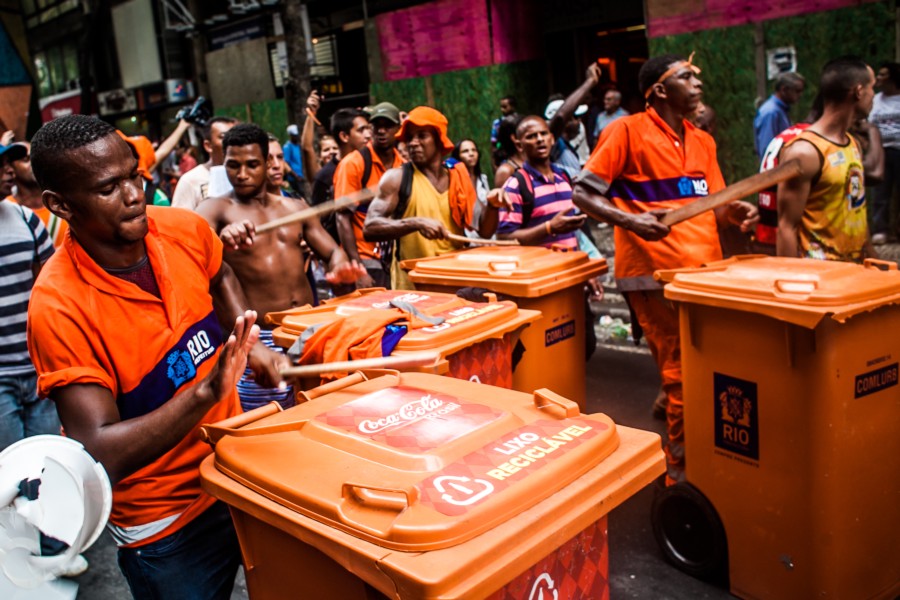 The offensive strategy was responded to with increased organization and the installation of a real participatory process by the garis. The popular organization and political consciousness was made clear. Creative acts and daily assemblies summed up the necessary conviction of unity and gave a great consistency to the movement. Day after day, the cohesion of the group was apparent.
The offensive strategy was responded to with increased organization and the installation of a real participatory process by the garis. The popular organization and political consciousness was made clear. Creative acts and daily assemblies summed up the necessary conviction of unity and gave a great consistency to the movement. Day after day, the cohesion of the group was apparent.
By confronting the dismissals and threats, instead of giving in to them, the garis created a fundamental atmosphere of confidence making the fight for their rights the central element for the creation of a group pact. The environment of unity and the capacity to create dialogue within the movement won them, on Ash Wednesday, an emblematic image.
Sorriso, the gari who became the symbol of the Rio Carnival (known nationwide because of the images transmitted by the network Globo, the same network that at this moment was condemning the strike in defense of the City, and known internationally for his appearances on stage during the 2012 London Olympics) adhered to the strike and went to the streets to participate in the event, even in the rain. The image of him lifted up onto the shoulders of his colleagues went viral on social networks and became news, the same way that his infectious dancing on the Sambodrome avenue had entertained millions of Brazilians all these years.
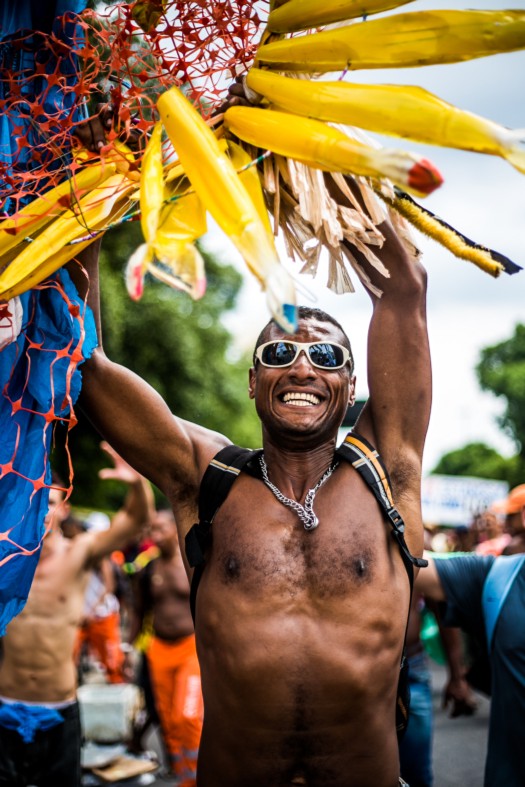 A symbolic counter attack, original and unexpected, was underway. Without addictive and classic ideological tactics, the movement came to the street and expressed their demands with joy. Taking advantage of the festive atmosphere of carnival, the protestors switched the march and lyrics of order for samba and good humored, provocative music. They brought an irreverent and relaxed sentiment to their fight. The “carnivalization” of politics, a typical process of an intellectualized festive left, now had a genuine, popular expression that was very authentic. Its infectious spirit spread not just to the already mobilized garis, but to public opinion as well.
A symbolic counter attack, original and unexpected, was underway. Without addictive and classic ideological tactics, the movement came to the street and expressed their demands with joy. Taking advantage of the festive atmosphere of carnival, the protestors switched the march and lyrics of order for samba and good humored, provocative music. They brought an irreverent and relaxed sentiment to their fight. The “carnivalization” of politics, a typical process of an intellectualized festive left, now had a genuine, popular expression that was very authentic. Its infectious spirit spread not just to the already mobilized garis, but to public opinion as well.
At the same time, the arduous daily work that the gari must endure physically prepared him for the marathon of protests and parades, organized daily for eight consecutive days. Uniting political consciousness, resistance and festivity showed everyone that it would not be easy to bypass them.
The Internet, fundamental in communicating information about the strike, was another great ally and the principle environment for counter-information.
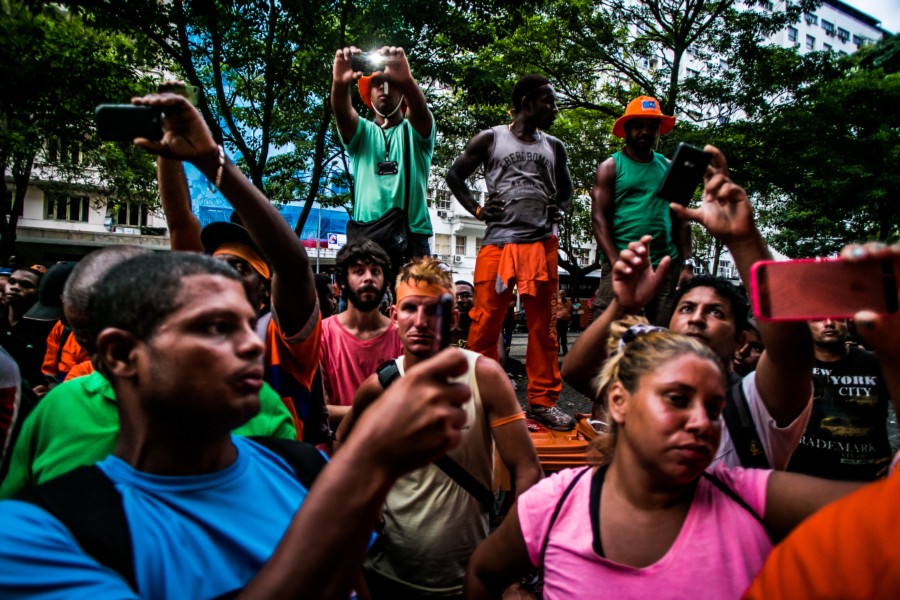 Live transmission of the protests and ample coverage with photos, videos, and updates posted by the garis and media activists unmasked the campaign of the old media and clearly presented the game of interests in dispute. Messages of support from other movements in Brazil and around the world appeared on the networks, and a strong wave of solidarity took shape.
Live transmission of the protests and ample coverage with photos, videos, and updates posted by the garis and media activists unmasked the campaign of the old media and clearly presented the game of interests in dispute. Messages of support from other movements in Brazil and around the world appeared on the networks, and a strong wave of solidarity took shape.
Political caricatures of the mayor and the trash in the city went viral. The public support and presence of independent media covering the strike were decisive in building escape routes for the symbolic struggle that was being carried out.
The trash and its smell continued to stay on the streets, but this was no longer just an issue for the garis.
The Golden Banner
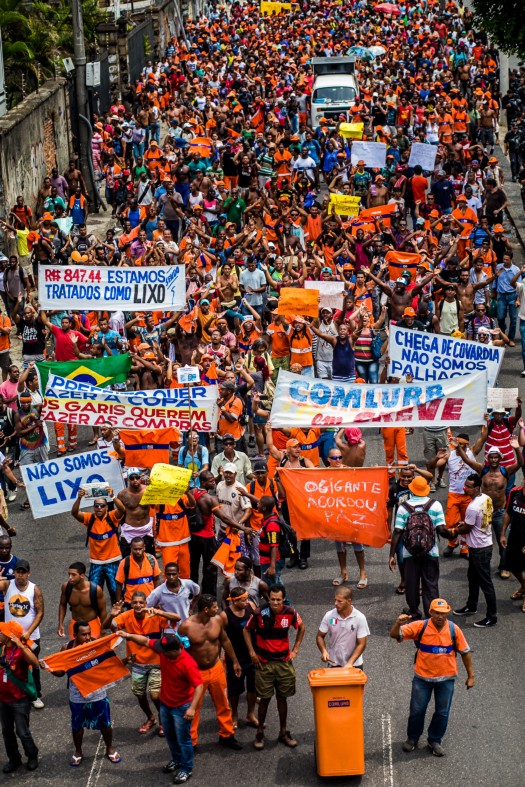 Two significant events occurred on March 6 and 7, after Ash Wednesday. At this point, the government’s attempt to reduce the workers on strike to an outraged minority was an evident fallacy.
Two significant events occurred on March 6 and 7, after Ash Wednesday. At this point, the government’s attempt to reduce the workers on strike to an outraged minority was an evident fallacy.
The 300 strikers had transformed into a multitude. The solidarity among their social class was clear and their capacity to resist was presented with a disconcerting, carnivalesque light-heartedness.
Saturday began with rain after days of continuous protest under Rio de Janeiro’s hot sun. The final act began at the Central do Brasil train station, and even with persistent rain throughout the morning, the presence of the garis was expressive. There, the recognition of the political movement and its new actors had become evident, as much for the mayor as society in general.
The Strikers’ Commission, ignored until now by the City, became a part of the official negotiations among the labor union, Comlurb and municipal authorities.
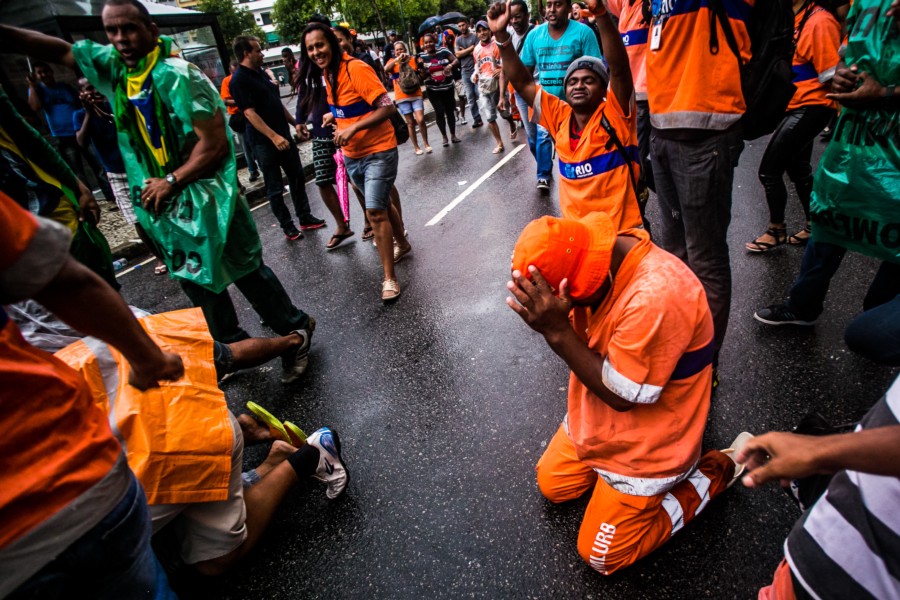 In a final manouver attempt, Eduardo Paes announced on Jornal RJTV of the Globo Network, that on that Saturday afternoon a meeting at the Regional Labor Tribunal (TRT) would decide the fate of the strike. Taken by surprise by the televised announcement, and without any official communication from the City, the strikers quickly reorganized their trajectory and headed towards the Tribunal to participate in the event and decide its course.
In a final manouver attempt, Eduardo Paes announced on Jornal RJTV of the Globo Network, that on that Saturday afternoon a meeting at the Regional Labor Tribunal (TRT) would decide the fate of the strike. Taken by surprise by the televised announcement, and without any official communication from the City, the strikers quickly reorganized their trajectory and headed towards the Tribunal to participate in the event and decide its course.
The pressure from the public in the last few days had softened the bases that until then had appeared inflexible in the negotiations with the City and the labor union. The waters of March, with its characteristic rain, started to flood the city with the amount of trash accumulated on the street and gutters. The international image of the country about to host the World Cup, less than 100 days until the opening, took on a fundamental importance with regards to the pressure imposed by the garis.
In the first round of negotiations City Hall insisted on a wage proposal that fell far short of what the strikers desired. Reunited in an assembly, the garis refused the new increase. The movement was able to strike a blow to the political arrogance of the speakers from the city government and the labor union.
And the city government gave in.
Eduardo Paes was forced to concede to the proposal made by the strikers’ commission. As a result, the wage rose from R$804.00 (US$345.00) to R$1100.00 (US$472), an increase of close to 37%, with an increase of 40% for workers’ compensation due to poor health conditions on the job. The food voucher rose from R$12 (US$5.15) to R$20 (US$9), an increase of 66%, and other rights such as a dental plan were achieved. Furthermore, the 1,100 dismissals, considered just cause by the City as a punitive measure, were repealed.
Had it been up to the labor union, the urban cleaning professionals of Rio de Janeiro would have had a meager 9% increase in wages. Had it been up to the City, they would have never stopped working. Had it been up to the mainstream media the movement would have been criminalized and defamed.
But the garis did not depend on any of them. They depended on their capacity to organize, their dignity, their joy, and their creative potential. It was because of all this that they were able to march their Orange Parade for the last time on Saturday, on the same day as the Carnival Champions parade, and definitively enter the history of fights and conquests of civil rights in this immature Brazilian democracy.
This year’s Carioca summer will be remembered for the great victory of the united garis, the political school that presented the best story for the country in 2014. May there be many more carnivals to come…

